Modeling and Pile-Driven Scaled Tests for Windfarm Foundations
Abstract
1. Introduction
- For the same tube, a greater speed required a greater force to achieve the same penetration.
- In addition, there were differences in the results obtained for hollow and flat situations. For flat penetration, a greater force was required to achieve the same drive length, which is a vital factor to take into account when designing offshore structures.
2. Materials and Methods
2.1. Previous Tests
2.2. Scale Tests
2.2.1. PISA Model: Dimensions and Speed Test
- Velocity load: diameter/300 or diameter/500 per minute;
- Pile diameters of 0.27 m, 0.76 m and 2 m;
- Pile thickness of 0.7 cm to 3.8 cm, with the condition of 30 < diameter/thickness < 80
- Entered lengths between 1.43 m and 10.5 m with the condition of 3 < length entered/diameter < 10.
2.2.2. Characteristics and Dimensions of Scale Submerged Test
- Characteristics of pool (Figure 1):
- ○
- 2 × 2 × 1 m pool and 5 mm thickness;
- ○
- Plate of 2.3 × 2.3 and 3 mm thickness that serves as the base of the pool.

2.2.3. Scale Test
2.2.4. Finite Element Modeling (FEM)
3. Results
3.1. Scale Submerged Tests
3.2. Finite Element Models
4. Discussion
5. Conclusions
5.1. Submerged Tests
5.2. Comparison between Dry and Submerged Tests
5.3. Comparison Scale Tests with Finite Elements Models
- Results in submerged conditions are smaller than results in dry conditions;
- Results in a flat position are more reliable than those in a hollow position;
- Finite element models can be applied, since the results were consistent in simulating the same conditions as full-scale tests;
- For the same tube, the driving force was practically the same for the different speeds.
Author Contributions
Funding
Conflicts of Interest
References
- Luengo Frades, J.; Negro Valdecantos, V.; García Barba, J.; Soriano Vicedo, J.; Martín-Antón, M. Blue economy: Compatibility between the Increasing Offshore Wind Technology and the Achievement of the SDG. J. Coast. Res. 2020, 95, 1490–1494. [Google Scholar] [CrossRef]
- Lam, I.P.O. Diameter effects on p-y curves. In Deep Marine Foundations—A Perspective on the Design and Construction of Deep Marine Foundations, Proceedings of the Third International Symposium on Frontiers in Offshore Geotechnics (ISFOG 2015), Oslo, Norway, 10–12 June 2015; Deep Foundations Institute: Hawthorne, NJ, USA, 2013. [Google Scholar]
- Luengo Frades, J.; Negro Valdecantos, V.; García Barba, J.; Lopez Guiterrez, J.S.; Esteban, M.D. New detected uncertainties in the design of foundations for offshore wind turbines. Renew. Energy 2019, 131, 667–677. [Google Scholar]
- Zhang, X.; Liu, C.; Ye, J. Model Test Study of Offshore Wind Turbine Foundation under the Combined Action of Wind Wave and Current. Appl. Sci. 2022, 12, 5197. [Google Scholar] [CrossRef]
- DNVGL-ST-0126; Support Structure for Wind Turbines. Det Norske Veritas: Oslo, Norway, 2016.
- API. RP 2A-WSD—Recommended Practice for Planning, Designing and Constructing Fixed Offshore Platforms; American Petroleum Institute: Washington, DC, USA, 2010. [Google Scholar]
- Arroyo, M.; Abadías, D.; Alcoverrro, J.; Gens, A. Shallow foundations for offshore wind towers. In Proceedings of the 18th International Conference on Soil Mechanics and Geotechnical Engineering, Paris, France, 2–6 September 2013. [Google Scholar]
- Randolph, M.F. Science and empiricism in pile foundation design. Géotechnique 2003, 53, 847–875. [Google Scholar] [CrossRef]
- Bülow, L.; Jorgensen, L.; Gravessen, H. Kriegers Flak Offshore Wind Farm. Basic Data for Conceptual Design of Foundations; Vattenfall Vindkraft AB: Stockholm, Sweden, 2009. [Google Scholar]
- Lesny, K. Foundations for Offshore Wind Turbines: Tools for Planning and Design; VGE: Essen, Germany, 2010. [Google Scholar]
- Lesny, K. Design approaches of Eurocode 7 and their effect on the safety of shallow foundations, ICASP10. In Applications of Statistics and Probability in Civil Engineering; Taylor & Francis: Abingdon-on-Thames, UK, 2007. [Google Scholar]
- Passon, P.; Branner, K.; Larsen, S.E.; Hvenekær Rasmussen, J. Offshore Wind Turbine Foundation Design; DTU Wind Energy: Roskilde, Denmark, 2015. [Google Scholar]
- Soriano Vicedo, J.; García Barba, J.; Luengo Frades, J.; Negro Valdecantos, V. Scale Tests to Estimate Penetration Force and Stress State of the Silica Sand in Windfarm Foundations. Energies 2021, 14, 5904. [Google Scholar] [CrossRef]
- Byrne, B.W.; McAdam, R.; Burd, H.J.; Houlsby, G.T. PISA-New Design Methods for Offshore Wind Turbines. In Proceedings of the 8th International Conference, Royal Geographical Society, London, UK, 1 January 2017. [Google Scholar]
- Taborda, D.M.G.; Zdravkovi, L.; Kontoe, S.; Potts, D.M. Computational study on the modification of a bounding surface plasticity model for sands. Comput. Geotech. 2014, 59, 145–160. [Google Scholar] [CrossRef]
- Chow, F.C. Investigations into the Behaviour of Displacement Piles for Offshore Foundations. Ph.D. Thesis, Imperial College, London, UK, 1997. [Google Scholar]
- Jardine, R.J.; Standing, J.R.; Chow, F.C. Some observations of the effects of time on the capacity of piles driven in sand. Géotechnique 2006, 554, 227–244. [Google Scholar] [CrossRef]
- Guillen, J.; Hoekstra, P. The equilibrium distribution of grain size fractions and its implications for cross-shore sediment transport: A conceptual model. Mar. Geol. 1996, 135, 15–33. [Google Scholar] [CrossRef]
- Lopez, I.; Lopez, M.; Aragones, L.; García-Barba, J.; Lopez, M.P.; Sánchez, I. The erosion of the beaches on the coast of Alicante: Study of themechanisms of weathering by accelerated laboratory tests. Sci. Total Environ. 2016, 567, 191–204. [Google Scholar] [CrossRef] [PubMed]
- Klyuev, R.V.; Bosikov, I.I.; Gavrina, O.A. Use of wind power stations for energy supply to consumers in mountain territories. In Proceedings of the 2019 International Ural Conference on Electrical Power Engineering (UralCon), Chelyabinsk, Russia, 1–3 October 2019. [Google Scholar]
- UNE 103 401; Determinación de los Parámetros Resistentes al Esfuerzo Cortante de Una Muestra de Suelo en la Caja de Corte Directo (Determination of the Shear Resistant Parameters of a Soil Sample in the Direct Cutting Box). UNE: Madrid, Spain, 2019.
- UNE-EN ISO 17892-9:2019; Investigación y Ensayos Geotécnicos. Ensayos de Laboratorio de Suelos. Parte 9: Ensayos de Compresión Triaxial Consolidados en Suelos Saturados de Agua (Geotechnical Investigation and Testing—Laboratory Testing of Soil—Part 9: Consolidated Triaxial Compression Tests on Water Saturated Soils. Part 6: Determination of Particle Density and Water Absorption). Asociacion Espanola de Normalizacion: Madrid, Spain, 2019.
- UNE-EN 1097-6; Ensayos Para Determinar las Propiedades Mecánicas y Físicas de los Aridos. Parte 6: Determinacion de la Densidad de Partículas y la Absorción de Agua (Tests to Determine the Mechanical and Physical Properties of Aggregates). UNE: Madrid, Spain, 2022.
- UNE-EN 933-1; Ensayos para Determinar las Propiedades Geométricas de los Áridos (Tests to Determine the Geometric Properties of Aggregates). UNE: Madrid, Spain, 2012.
- UNE-EN ISO 6892-1:2020; Materiales Metálicos. Ensayo de Tracción. Parte 1: Método de Ensayo a Temperatura Ambiente (Metallic Materials—Tensile Testing—Part 1: Method of Test at Room Temperature). UNE: Madrid, Spain, 2020.
- Kelly, R.B.; Houlsby, G.T.; Byrne, B.W. A comparison of field and laboratory caisson tests in sand and clay. Géotechnique 2006, 9, 617–626. [Google Scholar]
- Butlanska, J.; Arroyo, M.; Gens, A.; O’Sullivan, C. Multi-scale analysis of cone penetration test (CPT) in a virtual calibration chamber. Can. Geotech. J. 2014, 51, 51–66. [Google Scholar] [CrossRef]
- Phuong, N.T.V.; Van Tol, A.F.; Elkadi, A.S.K.; Rohe, A. Numerical investigation of pile installation effects in sand using material point method. Comput. Geotech. 2016, 73, 58–71. [Google Scholar] [CrossRef]
- Jiang, M.J.; Harris, D.; Zhu, H.H. Future continuum models for granular materials in penetration analyses. Granul. Matter 2007, 9, 97–108. [Google Scholar] [CrossRef]
- Soriano Vicedo, J.; Luengo Frades, J.; García Barba, J.; Negro Valdecantos, V. Modified soil test for scour analysis on offshore windfarm foundations. Trans. Eng. Sci. 2019, 125, 185–194. [Google Scholar]

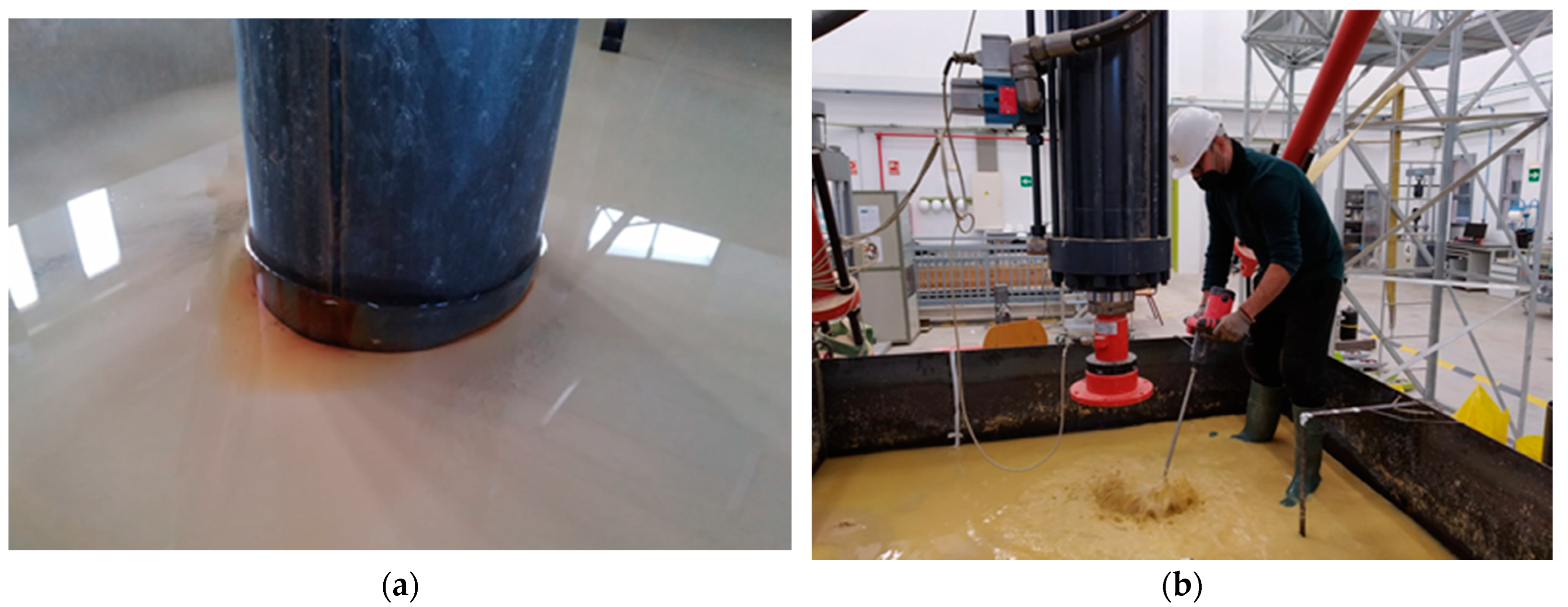
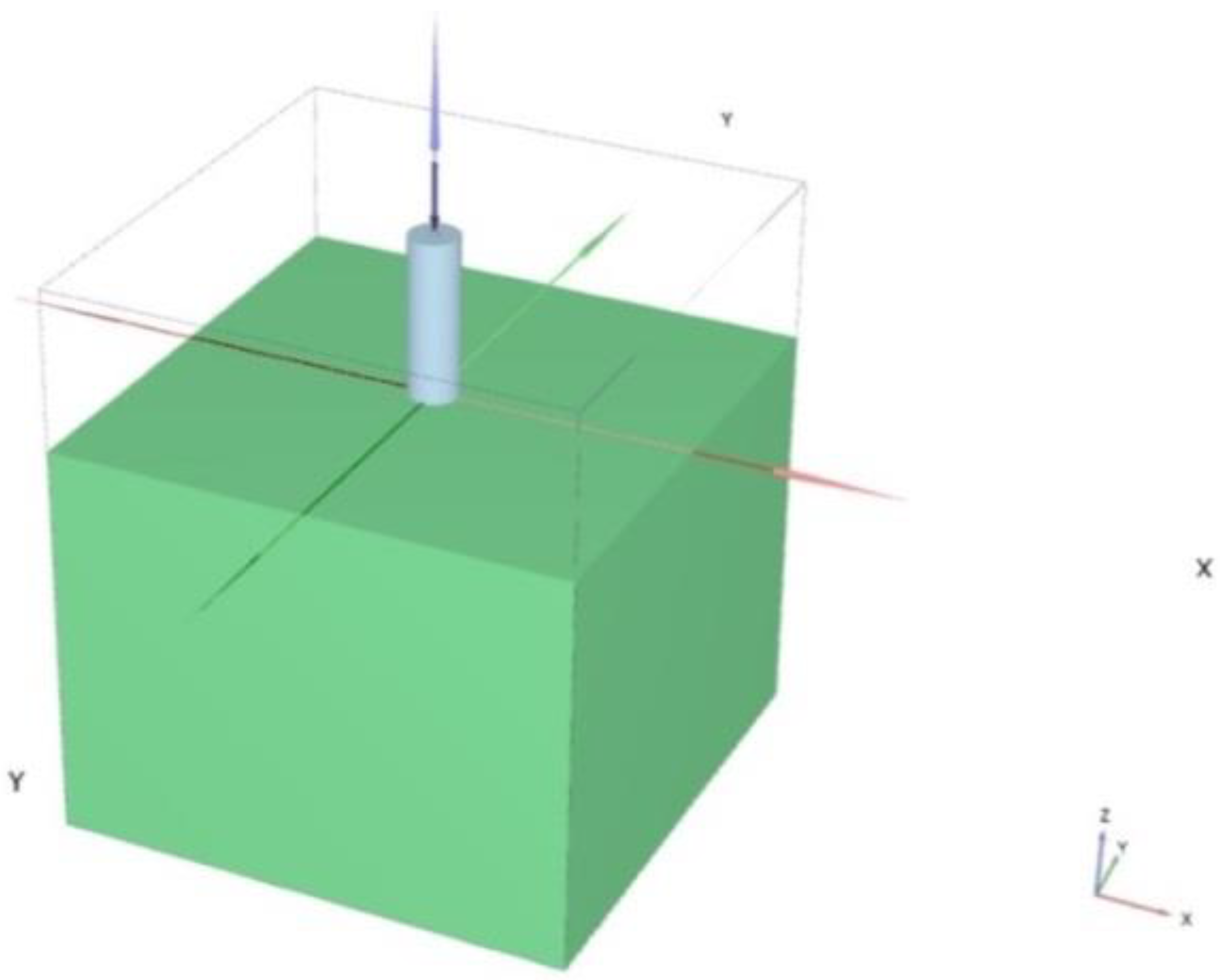
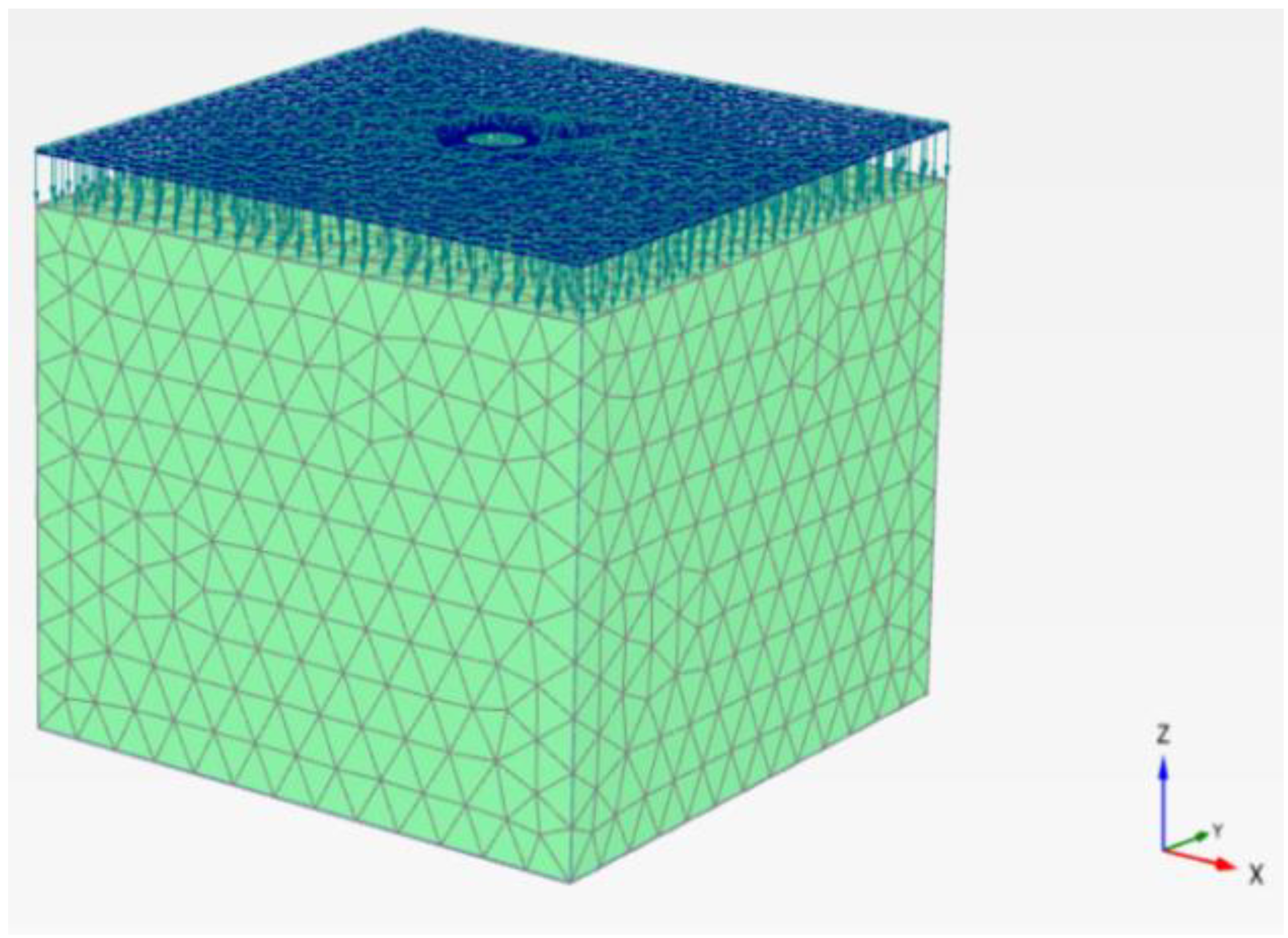


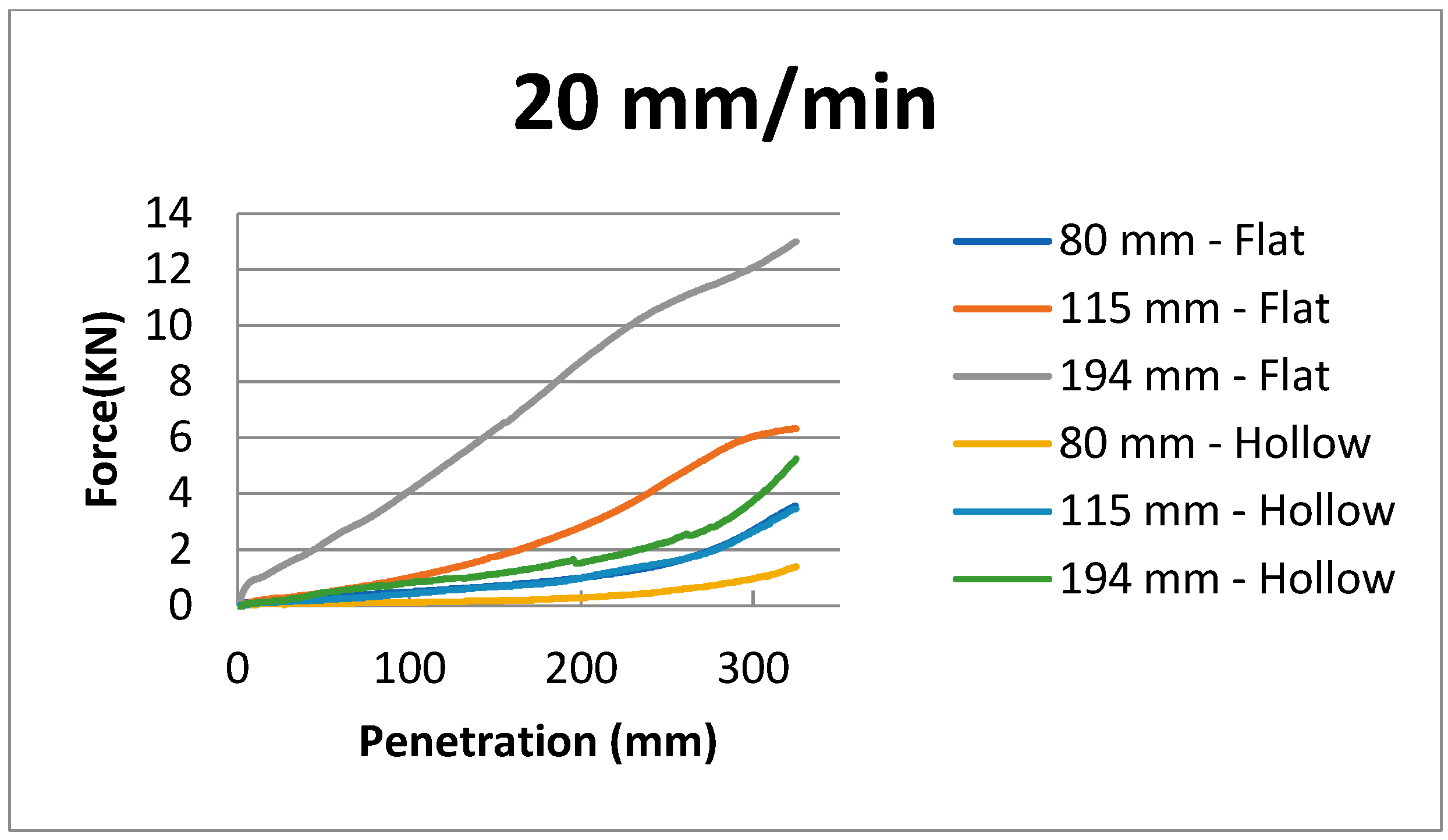
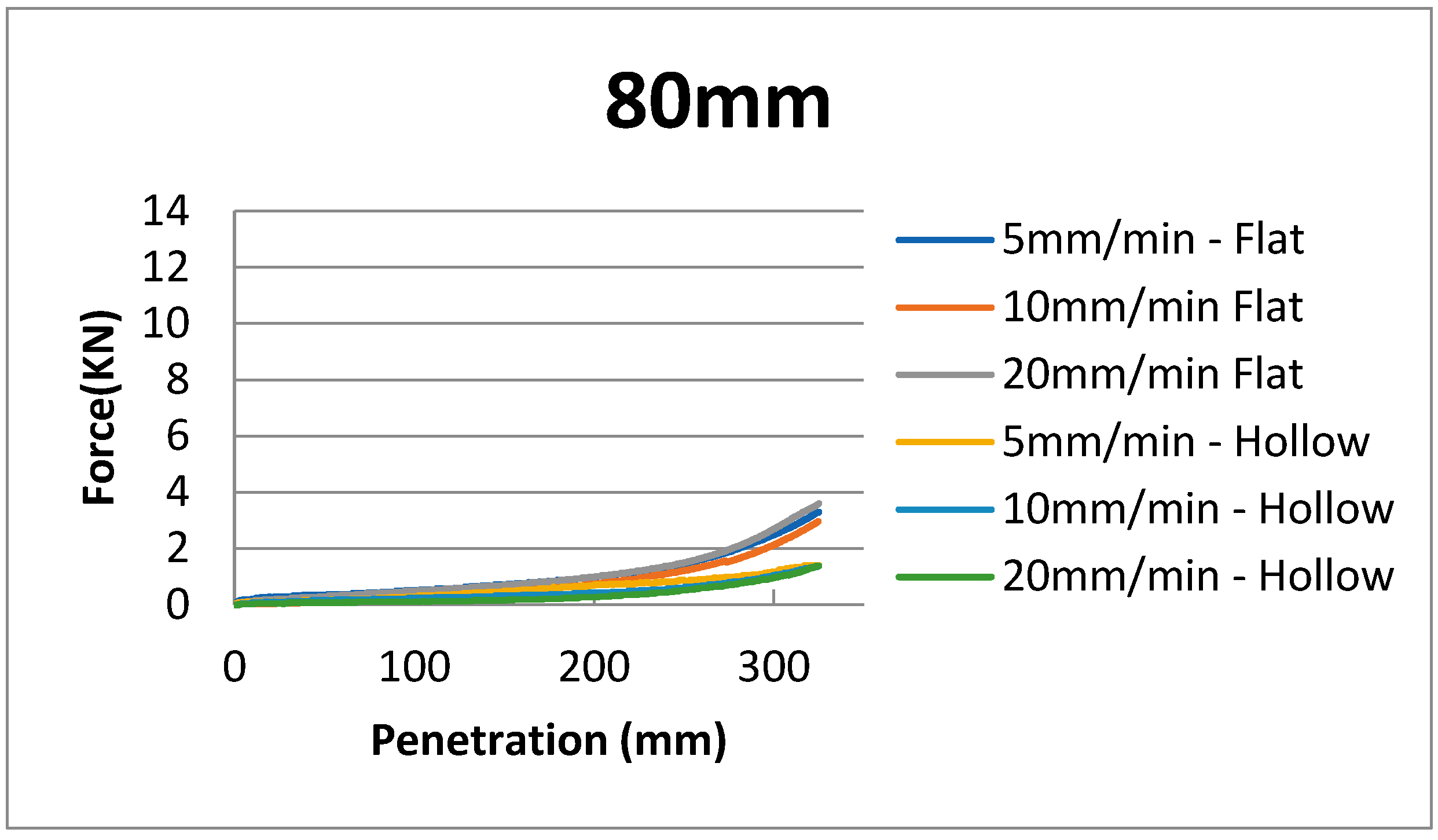
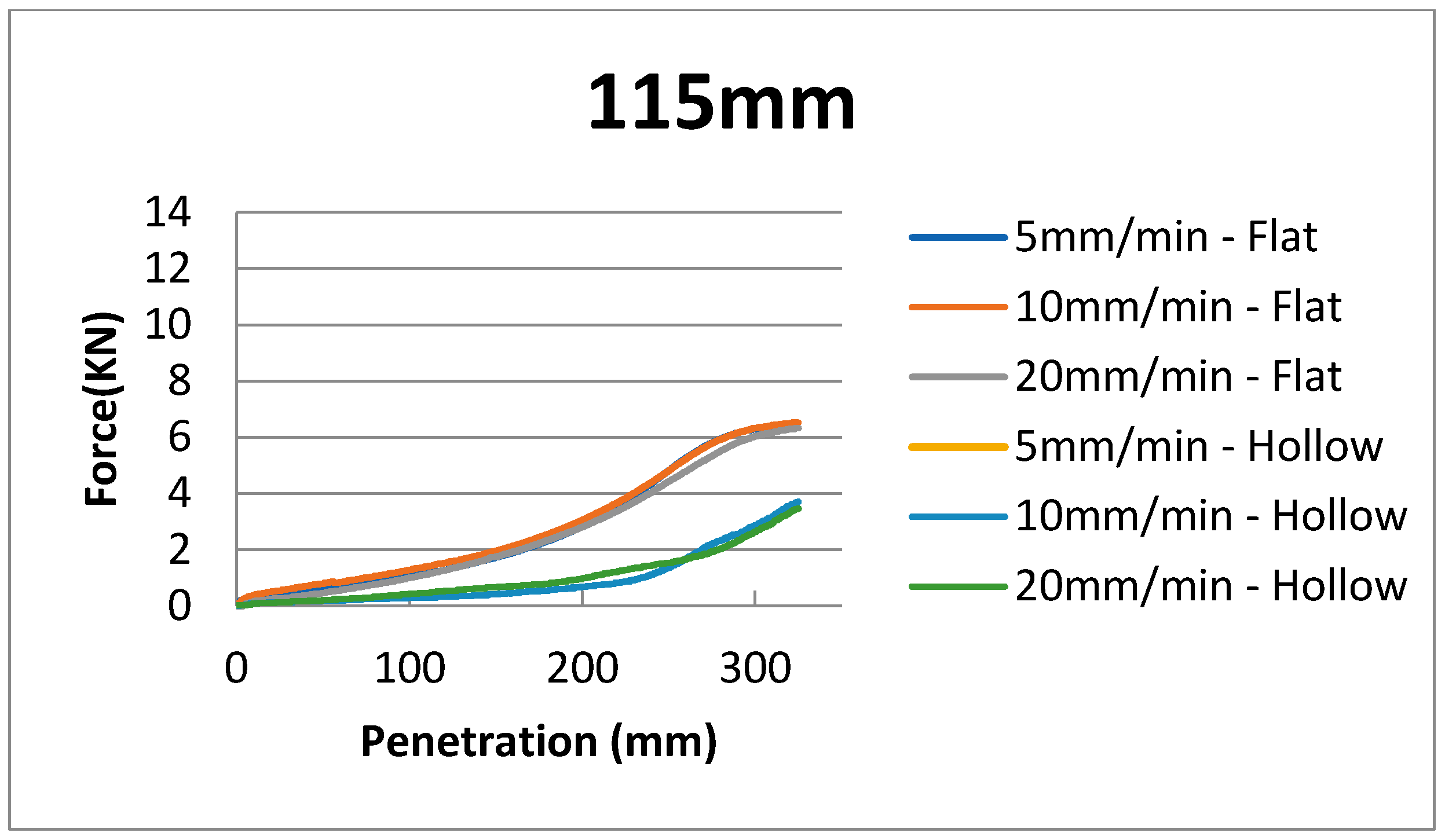
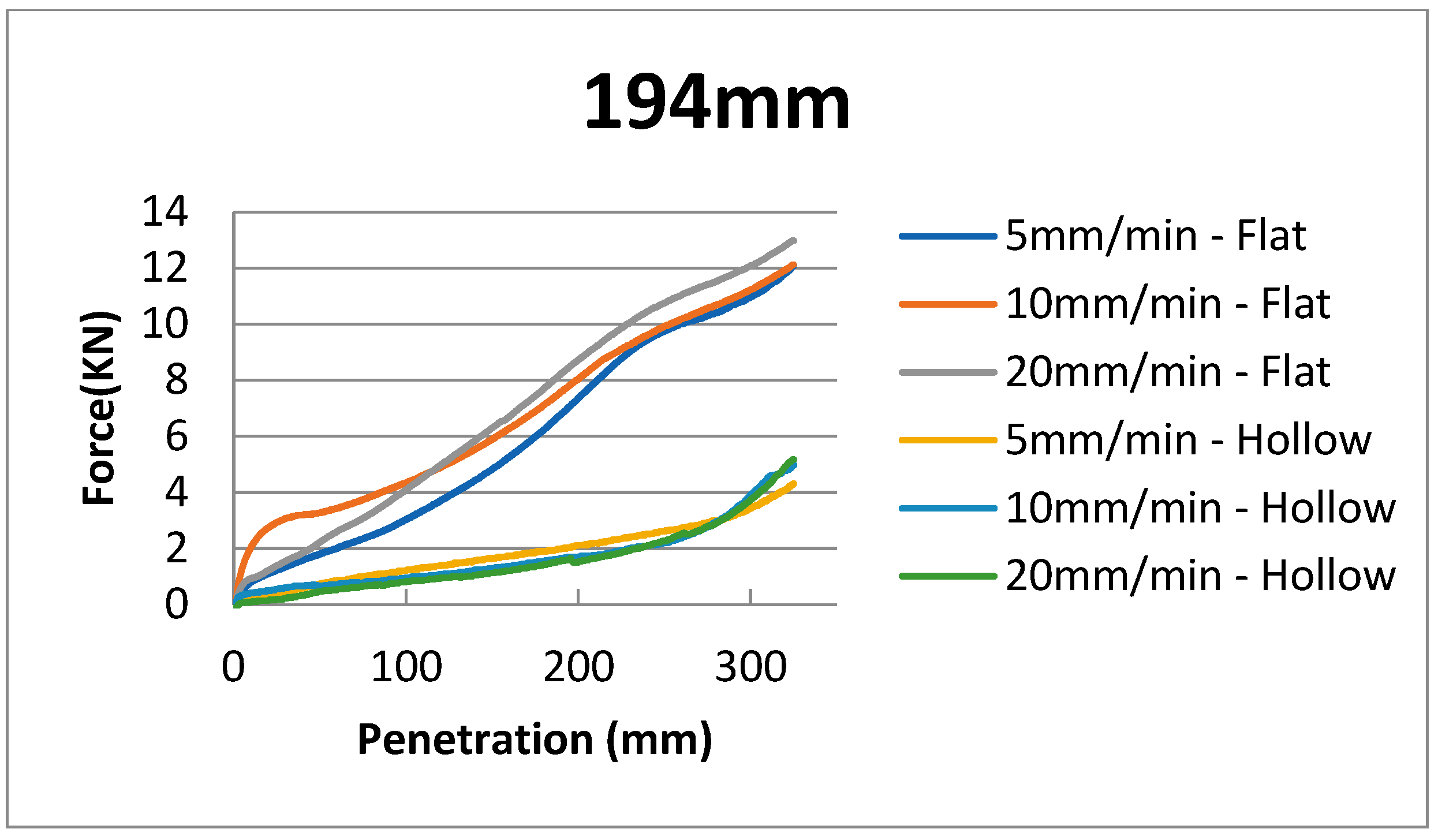

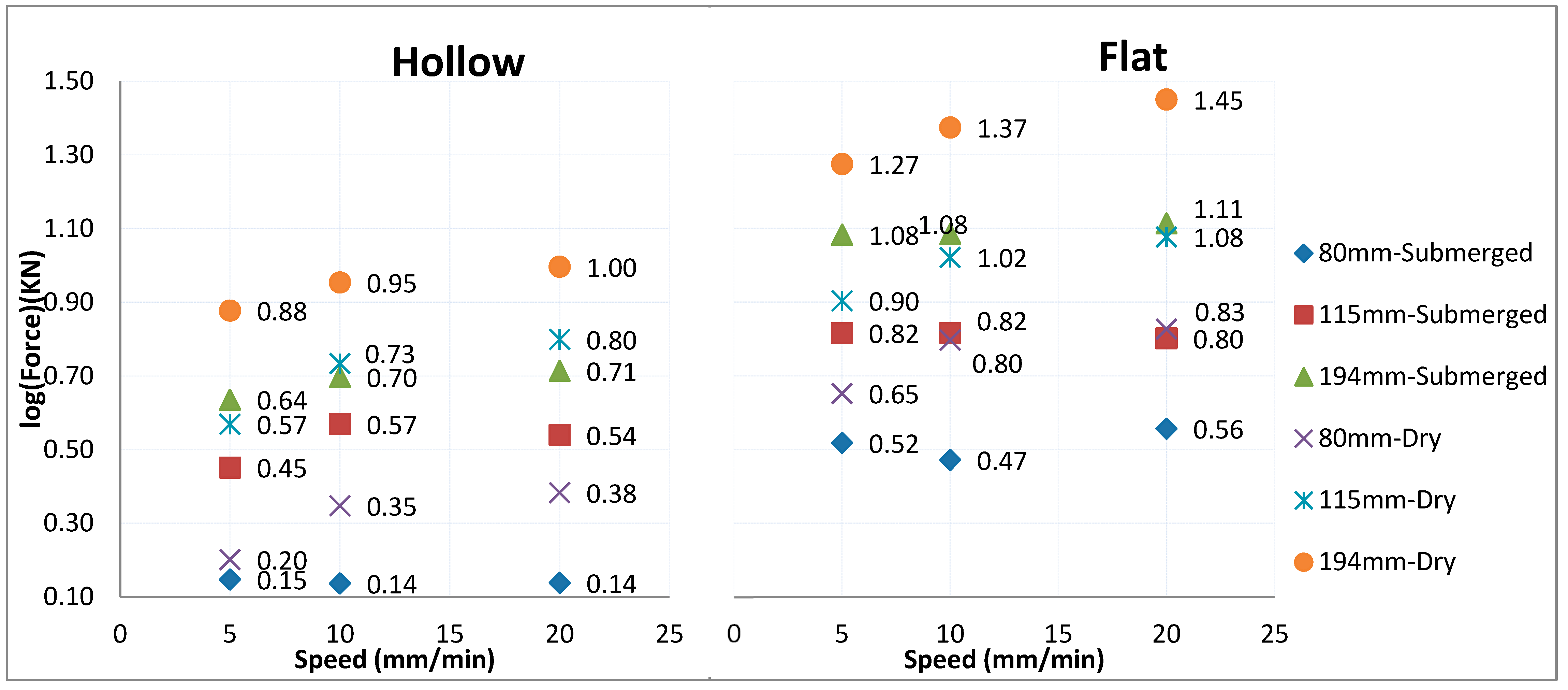

| Mechanical and Granulometric Characteristics of the Sand | ||||||
|---|---|---|---|---|---|---|
| Granulometric Analysis | Density Test | Direct Shear Test | Triaxial Shear Test | |||
| Grain Diameter (D50) | Uniformity Coefficient (Cu) | Coefficient of Curvature (Cc) | Density | Friction Angle (ϕ) | Cohesion (c) | Young’s Modulus (E) |
| 0.769 mm | 2.935 | 1.367 | 2.626 g/cm3 | 34.08° | 0 kg/cm2 | 21,570 kN/m2 |
| Dimensions (mm) | T1 | T2 | T3 |
|---|---|---|---|
| Total length | 910 | 700 | 600 |
| Entered length | 450 | 375 | 350 |
| Diameter | 194 | 115 | 80 |
| Thickness | 4 | 3 | 3 |
| 3 < E, length/diam < 10 | 2.3 | 3.26 | 4.06 |
| 30 < Diam/thick < 80 | 48.5 | 38.3 | 26.7 |
| GAUGE POSITION | NODE POSITION | |||||||
|---|---|---|---|---|---|---|---|---|
| AXIS | GAUGE | X (m) | Y (m) | Z (m) | 194-Submerged | 194-Dry | 115-Submerged | 115-Dry |
| X | 1 | −0.5 | 0 | −0.55 | 4121 | 4121 | 7103 | 7103 |
| X | 2 | −0.5 | 0.5 | −0.55 | 6956 | 6956 | 7225 | 7225 |
| Y | 3 | 0 | 0.5 | −0.5 | 7064 | 7064 | 4030 | 4030 |
| Y | 4 | −0.5 | 0.5 | −0.5 | 6956 | 6956 | 9951 | 9951 |
| 194-Submerged | Gauge_1 | Gauge_2 | Gauge_3 | Gauge_4 |
|---|---|---|---|---|
| NODE | 4121 | 6956 | 7064 | 6956 |
| Force (kN) | 0.696 | 0.696 | 0.696 | 0.696 |
| Nodal Displacement | 9.1090 × 10−5 | 2.2710 × 10−5 | 7.2610 × 10−5 | 2.7160 × 10−5 |
| Real Displacement | 7.4124 × 10−5 | 5.1947 × 10−6 | 7.4124 × 10−5 | 5.1947 × 10−6 |
| 194-Dry | Gauge_1 | Gauge_2 | Gauge_3 | Gauge_4 |
|---|---|---|---|---|
| NODE | 4121 | 6956 | 7064 | 6956 |
| Force (kN) | 5.824 | 5.824 | 5.824 | 5.824 |
| Nodal Displacement | 2.5250 × 10−4 | 7.2110 × 10−5 | 2.7760 × 10−4 | 6.5070 × 10−5 |
| Real Displacement | 6.2026 × 10−4 | 4.3469 × 10−5 | 6.2026 × 10−4 | 4.3469 × 10−5 |
| 115-Submerged | Gauge_1 | Gauge_2 | Gauge_3 | Gauge_4 |
|---|---|---|---|---|
| NODE | 7103 | 7225 | 4030 | 9951 |
| Force (kN) | 0.297 | 0.297 | 0.297 | 0.297 |
| Nodal Displacement | 1.2800 × 10−5 | 6.8590 × 10−6 | 3.2340 × 10−5 | 9.9330 × 10−6 |
| Real Displacement | 1.3312 × 10−5 | 2.2167 × 10−6 | 3.1631 × 10−5 | 2.2167 × 10−6 |
| 115-Dry | Gauge_1 | Gauge_2 | Gauge_3 | Gauge_4 |
|---|---|---|---|---|
| NODE | 7103 | 7225 | 4030 | 9951 |
| Force (kN) | 2.170 | 2.170 | 2.170 | 2.170 |
| Nodal Displacement | 8.3450 × 10−5 | 3.2190 × 10−5 | 8.0750 × 10−5 | 3.8550 × 10−5 |
| Real Displacement | 2.3110 × 10−4 | 1.6196 × 10−5 | 2.3110 × 10−4 | 1.6196 × 10−5 |
Disclaimer/Publisher’s Note: The statements, opinions and data contained in all publications are solely those of the individual author(s) and contributor(s) and not of MDPI and/or the editor(s). MDPI and/or the editor(s) disclaim responsibility for any injury to people or property resulting from any ideas, methods, instructions or products referred to in the content. |
© 2023 by the authors. Licensee MDPI, Basel, Switzerland. This article is an open access article distributed under the terms and conditions of the Creative Commons Attribution (CC BY) license (https://creativecommons.org/licenses/by/4.0/).
Share and Cite
Soriano Vicedo, J.; García Barba, J.; Cobelo, W.D.; Fernández, A. Modeling and Pile-Driven Scaled Tests for Windfarm Foundations. Energies 2023, 16, 4612. https://doi.org/10.3390/en16124612
Soriano Vicedo J, García Barba J, Cobelo WD, Fernández A. Modeling and Pile-Driven Scaled Tests for Windfarm Foundations. Energies. 2023; 16(12):4612. https://doi.org/10.3390/en16124612
Chicago/Turabian StyleSoriano Vicedo, Jorge, Javier García Barba, William Daniel Cobelo, and Aldo Fernández. 2023. "Modeling and Pile-Driven Scaled Tests for Windfarm Foundations" Energies 16, no. 12: 4612. https://doi.org/10.3390/en16124612
APA StyleSoriano Vicedo, J., García Barba, J., Cobelo, W. D., & Fernández, A. (2023). Modeling and Pile-Driven Scaled Tests for Windfarm Foundations. Energies, 16(12), 4612. https://doi.org/10.3390/en16124612





